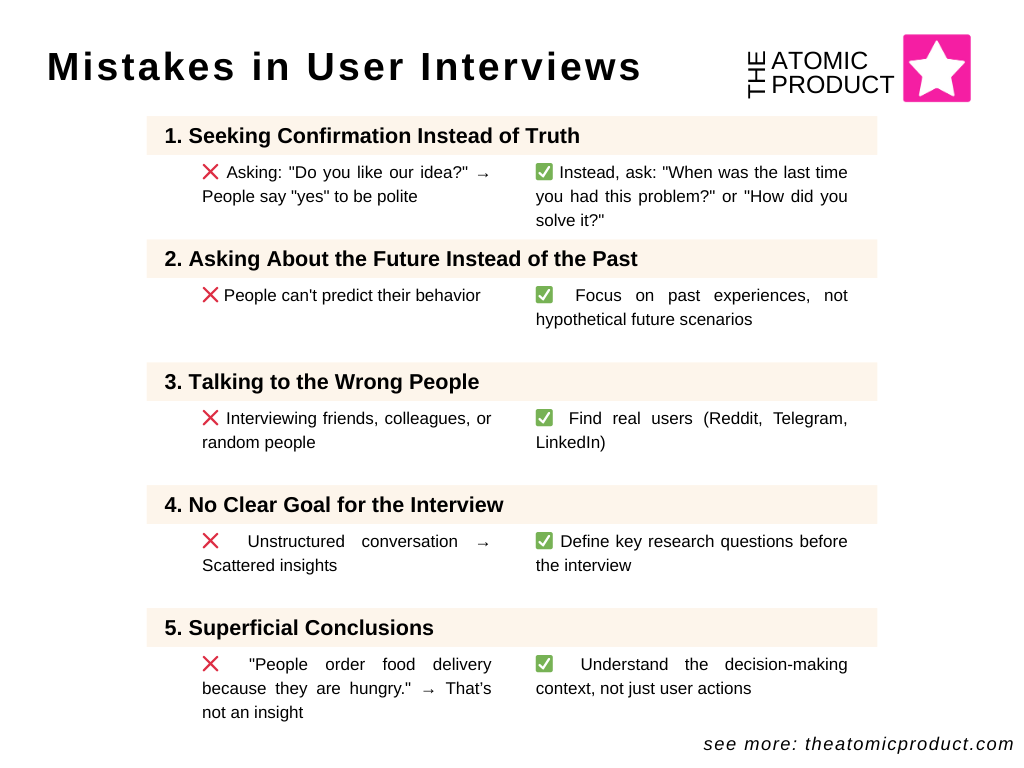User Interviews: How To Understand Users And Avoid Building The Wrong Product
Stop guessing. Start asking. Learn how great PMs use interviews to uncover real user needs and avoid costly mistakes.
Hey, Dmytro here — welcome to Atomic Product.
Every week, I share practical ideas, tools, and real-world lessons to help you grow as a product thinker and builder.
If you're new here, here are a few past posts you might find useful:
Practical Guide to User Interviews — Part 1: Preparation & Execution
Practical Guide to User Interviews — Part 2: Analysis & Insights
Hit subscribe if not on the list yet— and let’s roll 👇
Imagine you're building a bridge across a river. You don’t know how wide it is, how strong the current runs, or what the riverbed is made of. But you start building anyway, hoping for the best.
Now imagine you studied the river beforehand: measured the depth, analyzed the current, picked the right materials.
Which bridge would you trust more?
Building a product is no different. If you don’t understand your users, you're building a bridge to nowhere. It might look great — but no one will want to use it.
🔹 This article is your first step to avoiding that trap. Here's what we'll cover:
✔️ Why user interviews are one of the most powerful tools in a product manager’s toolbox
✔️ How they help at every stage — from idea to launch
✔️ Common mistakes even experienced PMs make (and how those lead to failure)
If you already get the “why” and want to jump into the how, check out the next article where we dive into the practical side: how to write good questions, avoid vague wording, and run the interviews effectively [link].
Why skipping interviews puts your product at risk
You came up with a brilliant idea. You told your friends, and they said:
— "Wow, sounds cool, I’d totally use that!"
You spent six months building it. Tens of thousands of dollars. You launched… and nothing happens. Silence.
What went wrong?
You trusted words, not behavior. People often say they’re interested in something, but that doesn’t mean they’ll actually use it — or pay for it.
Here are a few classic failure scenarios that interviews could have prevented:
🚨 Solving the wrong problem
You built a dating app that matches people based on IQ. You thought people were looking for smart conversations. Turns out they just want quick matches and hot photos.
🚨 Real problem, but not painful enough
You launched a tool to help corporate teams plan their yearly goals. People say: “Sounds useful,” but in reality, they’re fine with Excel and Slack — and don’t want to switch.
🚨 You can’t explain the value
You created a platform that speeds up call center workflows by 30%. Sounds important, right? But when you try selling it to B2B clients, they don’t get it. You’re not speaking their language.
In all these cases, user interviews would’ve helped you see the truth before burning time and money on the wrong build.
Where Do User Interviews Help?
First, remember: user interviews are not some isolated ritual. They’re part of your research process.
Before you sit down with users, you need to be clear on a few things:
– What’s your research goal?
– What hypotheses are you testing?
– Who is your target audience?
– What questions really matter right now?
If you haven’t figured this out yet — it’s too early for interviews. Otherwise, you’ll collect a bunch of scattered, low-value answers.
User interviews are conversations with users that help you understand:
✔️ What real problems they have
✔️ How they’re currently solving them
✔️ Why existing solutions don’t work for them
But it’s not just “opinion polling.” People don’t always tell the truth (more on that later).
A proper interview helps you cut through surface talk and get to the insights that really matter.
When are interviews essential?
1️⃣ Product Discovery – You’re at square one. Trying to figure out if there’s even a real problem.
2️⃣ Product Strategy – You know the problem exists, but not sure which solution will win.
3️⃣ Go-to-Market (GTM) – You need to figure out how to position and sell your product.
4️⃣ Pivot – The product isn’t working. You need clarity on why — and where to go next.
🔥 Example: Instagram
Back when Instagram was still called Burbn, it was packed with features — geolocation, check-ins, all sorts of social mechanics. The team thought users wanted gamification.
But interviews revealed something different: people just wanted beautiful photos.
Users were only uploading pictures to use the filters.
So the team stripped everything else away — and Instagram as we know it was born.
Common Mistakes in User Interviews
Even if you know interviews are important, it’s easy to do them wrong. Here are the most common traps:
🚨 1. You’re looking for validation, not truth
You ask:
— “What do you think about our smart-dating app idea?”
And people say:
— “Sounds cool!”
But that tells you nothing. People tend to agree out of politeness or to keep the conversation going.
👉 Fix it: Don’t ask if they like the idea. Ask:
✔️ “When was the last time you had this problem?”
✔️ “How did you solve it?”
✔️ “What didn’t work for you?”
🚨 2. You ask about the future instead of the past
People are terrible at predicting their behavior.
They’ll say they’d pay for something — but when the moment comes, they don’t.
🔥 Example: Airbnb
Early on, they asked homeowners:
— “Would you rent your home to travelers?”
Everyone said “yes”… but nobody signed up.
Only when the team asked about past behavior did they learn people were worried about safety and legal risks.
👉 Fix it:
✔️ Focus on past actions, not hypotheticals
✔️ Use the “5 Whys” technique to dig deeper
🚨 3. You’re talking to the wrong people
A common mistake: interviewing friends, coworkers, or just random folks.
🚨 Building something for HR managers? Don’t talk to developers.
🚨 Targeting freelancers? Skip the 9-to-5 crowd.
👉 Fix it:
✔️ Go where your real users are (Reddit, LinkedIn, Telegram, niche forums)
✔️ Prioritize people who’ve already tried solving the problem
🚨 4. You’re interviewing without a clear purpose
Another trap: running interviews without knowing what you're trying to learn.
The result? A messy chat and vague takeaways.
👉 Fix it:
✔️ Define a clear research question before you begin
✔️ Stay focused on specific user experiences — not abstract ideas
🚨 5. You’re drawing shallow conclusions
If your insight sounds like “people order food delivery because they’re hungry” — your interview didn’t dig deep enough.
👉 Fix it:
✔️ Don’t just focus on what users do — ask why they do it
✔️ Analyze the full context behind their decisions
What’s Next?
Even experienced product managers — people who’ve launched million-dollar products — often avoid or underestimate interviews.
Why?
In my experience, I’ve heard things like:
🚨 “I’ve launched products worth millions. I know what users want.”
That’s confirmation bias at work — when we look for proof that we’re right instead of seeking the actual truth.
But markets evolve, and so do user behaviors. What worked yesterday may fall flat tomorrow.
🚨 “It’s too slow and complicated.”
At first glance, interviews feel like endless conversations that are hard to analyze.
But here’s the irony: the cost of being wrong is 10x higher than the cost of doing proper interviews.
🚨 “Let’s just launch an MVP and see what happens.”
But launching an MVP without a validated hypothesis is just gambling.
You're hoping to hit the mark, but you don’t even know what you're testing.
The Real Reason Interviews Get Ignored
User interviews seem simple — but that’s what makes them tricky.
The devil’s in the details:
❌ Poorly phrased questions can distort reality
❌ The wrong people can lead you to false insights
❌ Shallow analysis won’t uncover real motivations
That’s why we put together a follow-up article — a practical guide to running user interviews.
In the next piece, we’ll walk through:
✔️ How to create an interview guide that actually works
✔️ Common mistakes in question phrasing — and how to fix them
✔️ How to structure and run the interview process to get valuable, actionable insights
📌 Ready for the “How”?
User Interviews aren’t just conversations. They’re a method. A mindset.
When done right, they help you make smart product decisions based on real data — not gut feelings or guesses.
This was the “why” behind user interviews — why they matter and how they can make or break your product.
If you’re ready to dive into the “how,” check out the next parts of this series:
👉 Practical Guide to User Interviews — Part 1: Preparation & Execution
How to plan, write good questions, recruit the right people, and run interviews that surface real insight.
👉 Practical Guide to User Interviews — Part 2: Analysis & Insights
How to make sense of what you heard, identify patterns, and turn raw conversations into product decisions.
🔥 Want to go deeper? Here are three must-read books on the topic:
📖 The Mom Test by Rob Fitzpatrick — how to ask better questions and get honest feedback
📖 Lean Customer Development by Cindy Alvarez — how to validate ideas without wasting time and money
📖 Talking to Humans by Giff Constable — how to find the right people to interview and actually learn from their answers
Thanks for reading Atomic Product.
If this resonated, feel free to reply, share your thoughts, or tell me how you approach user interviews.
Talk soon,
— Dmytro



